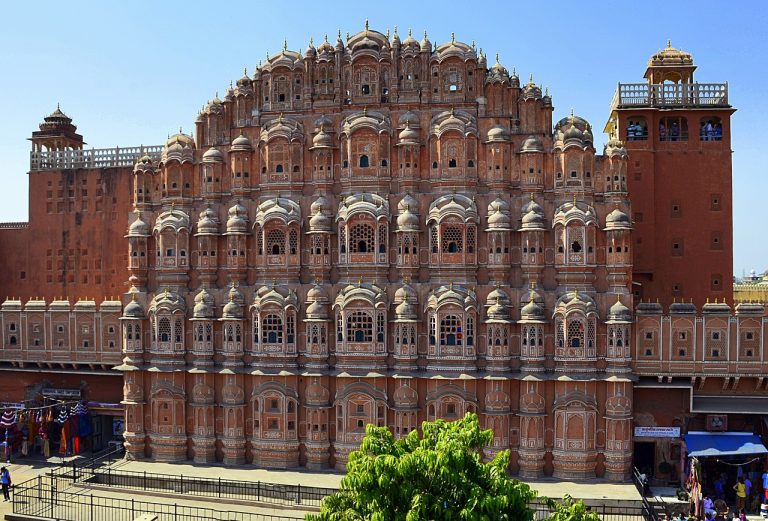Step into the rich history of Jaipur's most iconic landmark, the Hawa Mahal. With its unique honeycomb-like structure and pink hues, this architectural marvel has stood the test of time, preserving the tales of Rajasthan's royal legacy. From the intricate latticework to the 953 small windows designed to catch the cool breeze, every element of this palace whispers the secrets of a bygone era.
As you explore the history of Hawa Mahal, you'll unravel the stories of the royal women who once gazed upon the bustling streets from behind its ornate windows, offering a glimpse into their secluded yet captivating world. Discover the cultural and architectural significance of this "Palace of Winds" that has captivated travelers and historians for centuries.
From its construction in 1799 by Maharaja Sawai Pratap Singh to its enduring presence as a symbol of Jaipur's heritage, this article delves into the captivating journey of Hawa Mahal, inviting you to immerse yourself in the allure of this timeless treasure.
Construction and Architecture of Hawa Mahal
The construction of Hawa Mahal was commissioned by Maharaja Sawai Pratap Singh, the grandson of Maharaja Sawai Jai Singh, the founder of Jaipur. The renowned architect Lal Chand Ustad designed this five-story palace, which forms a part of the City Palace complex. The unique feature of the palace lies in its pyramid shape and its 953 jharokhas or small windows. These windows, adorned with intricate latticework, were designed to allow the royal ladies to observe the city's activities while remaining unseen from the outside.
The architectural style of Hawa Mahal reflects a fusion of Rajput and Mughal architectural elements. The palace is constructed of red and pink sandstone, symbolic of the Rajputana architecture, and its design is reminiscent of the crown of Lord Krishna. The structure's pyramidal shape, resembling Lord Krishna's crown, is a testament to the ingenious architectural prowess of the bygone era.
The interiors of Hawa Mahal are adorned with delicate motifs and carvings, showcasing the craftsmanship of the artisans of that time. The palace's unique design not only facilitated natural air conditioning but also exemplified the artistic finesse of the period. Its distinctive architectural style has made it a prominent symbol of Jaipur's rich cultural heritage.
Significance of Hawa Mahal in Jaipur's History
Hawa Mahal holds immense historical significance in the annals of Jaipur's history. It served as an extension of the royal City Palace, offering the royal women a vantage point to observe the city's bustling activities while maintaining their privacy. The palace's strategic location near the City Palace and the Sireh Deori Bazaar underscores its importance as a significant part of the royal complex.
The construction of Hawa Mahal was not just an architectural marvel; it was a testament to the forward-thinking approach of the rulers of Jaipur. The palace's purpose was not only to provide the royal women with a secluded space but also to celebrate the artistic and cultural heritage of the region. This cultural significance has cemented its position as a symbol of Jaipur's rich history and tradition.
Hawa Mahal also served as a venue for royal celebrations and processions, further emphasizing its integral role in the city's royal affairs. Its historical significance extends beyond its architectural grandeur, encapsulating the opulence and grandeur of Jaipur's royal legacy.
Hawa Mahal's Role in Jaipur's Cultural Heritage
The cultural heritage of Jaipur is incomplete without the inclusion of the illustrious Hawa Mahal. This architectural gem stands as a testament to the artistic and cultural finesse of the Rajputana era. The palace's intricate latticework, ornate carvings, and unique design reflect the cultural ethos of the region, showcasing a blend of Rajput and Mughal architectural styles.
Hawa Mahal's significance in Jaipur's cultural heritage lies in its ability to preserve the traditions and grandeur of a bygone era. The palace stands as a living testament to the opulence and artistic prowess of the royal patrons of Jaipur. Its inclusion in the UNESCO World Heritage Site inscription for the Hill Forts of Rajasthan is a testament to its pivotal role in preserving the cultural heritage of the region.
The palace's cultural significance extends beyond its architectural brilliance; it serves as a living museum, narrating the tales of the royal lifestyle, artistic pursuits, and cultural celebrations of the era. As an integral part of Jaipur's cultural landscape, Hawa Mahal continues to intrigue and inspire visitors with its timeless allure.
Notable Features of Hawa Mahal
The notable features of Hawa Mahal are a testament to its architectural and historical significance. The palace's distinctive pyramid-shaped façade, adorned with 953 jharokhas, stands as a hallmark of Rajputana architecture. The intricate latticework on the windows, crafted with precision, allows the gentle flow of air while providing a veiled view of the outside world.
The palace's five stories, each adorned with balconies and corridors, offer a glimpse into the opulent lifestyle of the royal women. The delicately carved motifs and embellishments within the palace showcase the unparalleled craftsmanship of the artisans of that era. The stunning view from the top floors of the palace, overlooking the bustling streets of Jaipur, adds to its allure and mystique.
The interior courtyards of Hawa Mahal are adorned with elegant fountains, intricate gardens, and vibrant murals, offering a serene retreat within the palace complex. The fusion of architectural grandeur and artistic finesse makes Hawa Mahal an epitome of beauty and grace, captivating the imagination of all who behold its splendor.
Hawa Mahal's Popularity Among Tourists
Hawa Mahal's captivating allure and rich historical significance have made it a must-visit attraction for tourists visiting Jaipur. The palace's architectural grandeur, coupled with its intriguing history, attracts visitors from across the globe, eager to immerse themselves in the opulence of Rajasthan's royal legacy.
The palace's strategic location in the heart of Jaipur makes it easily accessible to tourists exploring the city's vibrant cultural landscape. Its proximity to other renowned landmarks, such as the City Palace and Jantar Mantar, further enhances its appeal as a prominent tourist destination. Visitors are enchanted by the palace's unique design, offering a glimpse into the royal lifestyle and architectural finesse of a bygone era.
The palace's popularity among tourists is also attributed to its inclusion in various travel itineraries and cultural tours, allowing visitors to delve into the rich heritage of Jaipur. The allure of Hawa Mahal lies not only in its architectural splendor but also in the captivating stories and legends that surround this timeless monument.
Restoration and Preservation Efforts of Hawa Mahal
The restoration and preservation of Hawa Mahal stand as a testament to the commitment to safeguarding the cultural heritage of Jaipur. Over the years, various conservation efforts have been undertaken to ensure the structural integrity and aesthetic appeal of the palace are preserved for future generations.
The restoration initiatives have focused on maintaining the palace's iconic façade, intricate latticework, and delicate carvings, ensuring that its architectural grandeur remains unmarred by the passage of time. The meticulous efforts of conservationists and heritage experts have contributed to the palace's inclusion in the list of meticulously preserved heritage sites in India.
The ongoing preservation efforts underscore the collective commitment to safeguarding the legacy of Hawa Mahal, ensuring that its timeless allure continues to enthrall visitors for generations to come. The meticulous restoration work has not only preserved the architectural brilliance of the palace but also breathed new life into its cultural significance, making it a cherished emblem of Jaipur's heritage.
Hawa Mahal in Popular Culture and Media
Hawa Mahal's timeless charm has captured the imagination of artists, filmmakers, and writers, permeating popular culture and media with its enigmatic presence. The palace's captivating silhouette and ornate façade have been immortalized in various artistic renditions, showcasing its enduring appeal as a symbol of architectural splendor.
The palace's inclusion in numerous films and documentaries has further amplified its cultural significance, bringing the tales of its royal legacy to a global audience. Its portrayal in cinematic masterpieces has served to immortalize the palace's allure, casting it as a captivating backdrop for tales of romance, valor, and regal opulence.
Hawa Mahal's depiction in literature, art, and photography has also contributed to its widespread recognition, solidifying its position as an emblem of Jaipur's cultural heritage. The palace's inclusion in travelogues and cultural narratives has invited travelers and enthusiasts to unravel the mystique of this architectural marvel, perpetuating its timeless appeal across diverse forms of media.
Tips for Visiting Hawa Mahal
When planning a visit to Hawa Mahal, consider the following tips to make the most of your experience: – Visit during the early morning or late afternoon to witness the palace bathed in the soft glow of the rising or setting sun, accentuating its pink hue. – Engage the services of a knowledgeable guide to gain insights into the palace's history, architectural nuances, and intriguing anecdotes. – Explore the nearby attractions, such as the City Palace and Jantar Mantar, to immerse yourself in Jaipur's rich cultural tapestry. – Capture the intricate details of the palace's architecture and design through photography, preserving the memories of your visit. – Respect the cultural significance of the palace and adhere to the guidelines for visitors to ensure the preservation of this historical treasure.
Conclusion
As you conclude your exploration of the history of Hawa Mahal, a sense of reverence for this architectural masterpiece envelops you. The palace's enduring legacy, steeped in regal opulence and cultural significance, leaves an indelible impression on all who traverse its ornate corridors and balconies. Hawa Mahal stands as a testament to the architectural finesse and cultural heritage of Jaipur, inviting visitors to partake in its timeless allure and immerse themselves in the tales of Rajasthan's royal legacy. As you bid farewell to this "Palace of Winds," the echoes of its grandeur linger, beckoning you to revisit its captivating splendor and unravel the enigmatic stories woven within its honeycomb-like walls.
The captivating journey of Hawa Mahal, from its construction in 1799 to its enduring presence as a symbol of Jaipur's heritage, invites you to immerse yourself in the allure of this timeless treasure. Whether you seek to delve into its architectural grandeur, uncover its historical significance, or simply bask in its timeless charm, Hawa Mahal stands as a living testament to the opulence and cultural legacy of Rajasthan.




0 Comments